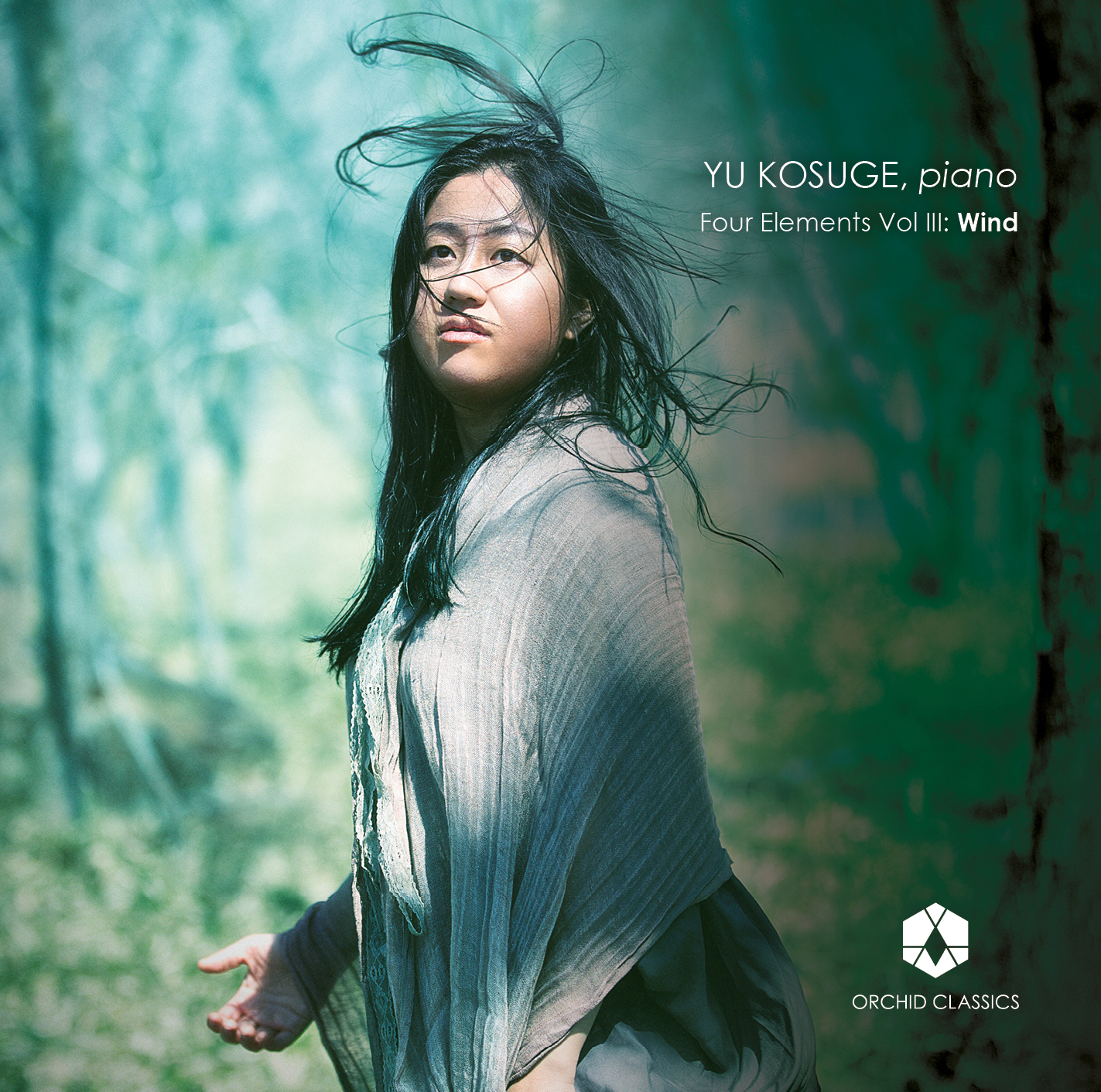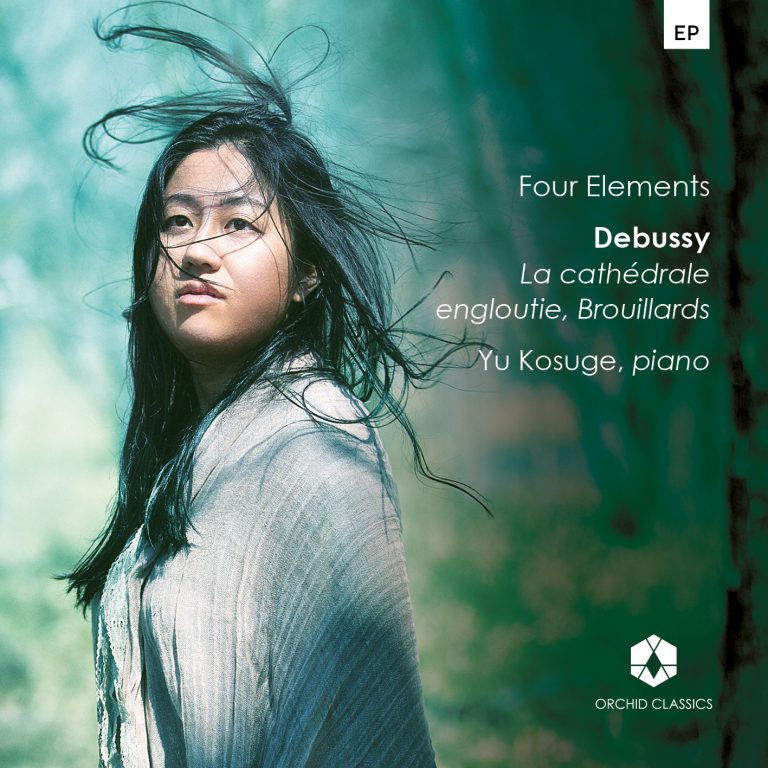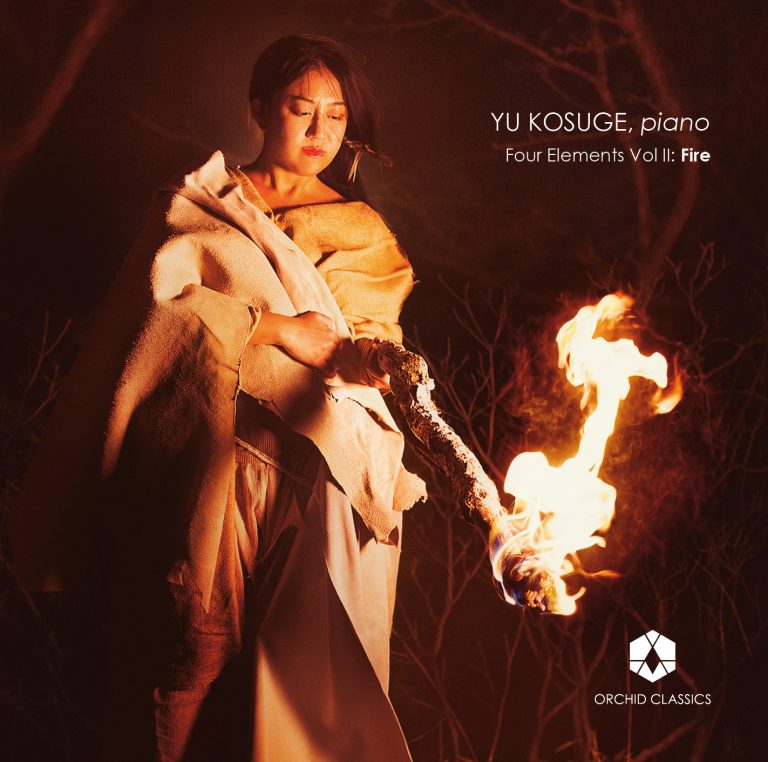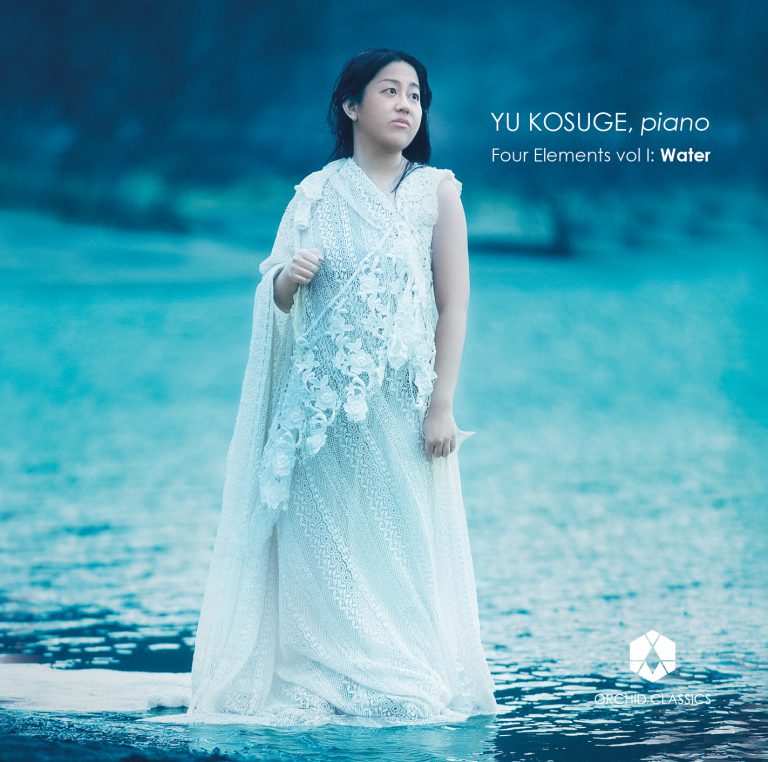Artist Led, Creatively Driven

Yu Kosuge
Four Elements vol.3: Wind
Release Date: March 5th
ORC100159
Four Elements: Wind
Louis-Claude Daquin (1694-1772)
from Premier livre de pièces de clavecin
1 “Le coucou” 2.26
2 “Les vents en courroux” 3.20
François Couperin (1668-1733)
from Troisième livre de pièces de clavecin
3 “Les petits moulins à vent” 3.20
Jean-Philippe Rameau (1683-1764)
from Deuxième livre de pièces de clavecin
4 “Le Rappel des oiseaux” 3.57
Akira Nishimura (b.1953)
5 Kalavinka (2006) 9.54
Ludwig van Beethoven (1770-1827)
Piano Sonata Op.31 No.2 “Tempest”
6 Largo – Allegro 10.27
7 Adagio 8.36
8 Allegretto 7.03
Claude Debussy (1862-1918)
from Préludes, Book 1
9 No.2 “Voiles” 4.06
10 No.3 “Le vent dans la plaine” 2.08
11 No.7 “Ce qu’a vu le vent d’ouest” 3.19
Leoš Janáček (1854-1928)
In the Mists
12 Andante 4.25
13 Molto adagio 5.49
14 Andantino 3.49
15 Presto 5.41
Total time 78.25
Yu Kosuge, piano
“Le vent se lève!… Il faut tenter de vivre!”
from Le Cimetière Marin by Paul Valéry
The Four Elements series reaches its turning point and this time, the theme is “wind”.
In the Old Testament, Genesis tells of the birth of Adam, the first human, in this way: “God formed man of the dust of the ground, and breathed into his nostrils the breath of life; and man became a living soul.” (transl. from The King James Bible) Christianity, mythology and ancient legends instil a belief in something invisible like a soul or spirit in human life. In ancient Greek, the word “pneuma” originally meant “air, wind or breath”, but was later understood as “principle of existence”. It also shares this origin with the Latin word spiritus which evolved then to spirit in English, and to esprit in French.
In Four Elements Vol.3 I focus on the invisible: Breath, Wind, Air, Soul, and Life. From natural depictions of fresh breeze, through the mysterious world of gods, to pieces which reflect most intimately on the human soul.
“French music means clarity, elegance, simple and natural recitative. And above all it brings about joy. Couperin and Rameau, they are true Frenchmen.”
Claude Debussy April 2nd 1904 from “La Revue bleue”
The first four pieces on this release were all written in the French Baroque period for Clavecin (harpsichord). Since the end of the 17th century, pieces for Clavecin became very popular with the Royal family. While dances were most common in the beginning, lots of later works were titled with a theme from daily life, human emotion or nature. These elegant, beautiful pieces demand not only virtuosity and clarity of sound but also great imagination.
Daquin, Couperin and Rameau were all distinguished organists but developed different careers.
Louis-Claude Daquin (1694-1772), the youngest of the three was born to an intellectual Jewish family. As a child prodigy he already played for Louis XIV at the age of six, and at eight he conducted a choral symphony, and was appointed organist of the Church in Petit Saint-Antoine at the age of twelve. In 1727 Daquin beat Rameau to a post at Saint Paul. In addition in 1732 he took a position at Cordeliers and was then court organist at Chapelle Royale under Louis XV.
The sound of nature is apparent in his Livre de Pièces de Clavecin. In “Le coucou”, the figure in the right hand circles around as if wind is blowing, while the cuckoo’s voice can be heard in the left hand throughout the piece. In ”Les vents en courroux”, the wild, swirling wind is expressed by virtuosic scales and arpeggios going up and down as if in fury.
Francois Couperin (1668-1733), who, like Bach, comes from a large musical family was an organist of Chapelle Royale under Louis XIV and XV and taught clavecin to the Royal family. In “Les petits moulins à vent”, a peaceful daily life can be imagined while the circling figures move lyrically in a canon imitating the vanes of a windmill.
Jean-Philippe Rameau (1683-1764) held positions as organist in Avignon, Clairemont-Ferrant, Dijon and Lyon. He also was a music theorist. Rameau mainly composed pieces for clavecin in the first half of his life, while in the second half he focused more on opera. Lots of birds are singing and lamenting in “Le Rappel des oiseaux”, while the harmony suggests melancholy in the beauty of their voices.
The journey of wind continues from real birds to an imaginary creature with wings:
Akira Nishimura (b.1953), a renowned Japanese composer, winner of the Queen Elizabeth competition and Luigi Dallapiccola Composition Award, Milan 1977, also studied Asiatic traditional music, religion, aesthetics, cosmology, and heterophonic concept. These influences are heard in his music to the present day. “Kalavinka” was written for my recital debut at Salzburg Festival in 2006. Nishimura writes: “In the Buddhism sutra of Amitabha, Kalavinka is a specially shaped bird of paradise. This bird has a human face, the body of a bird and a beautiful voice, which sings the words of Buddha and thereby saves the human soul. The image of the paradise where Kalavinka lives comes from “Taizou Mandara” of Toji Temple in Kyoto, Japan. The universe of Mandara is like the inside of a woman’s womb which is filled with lights of various colours and with spiritual and sensual scent. There, soft and glamorous bodies of Buddhas are surrounding the Vairocana (the supreme Buddha) who is like a child with pink and youthful skin. This paradise universe is filled with mysterious and voluptuous eroticism. Kalavinka dances there and sings to us in the world of suffering.”
The Piano Sonata Op.31 No.2 “The Tempest” by Ludwig van Beethoven
(1770-1827) was written between 1801 and 1802. In October 1802 his deteriorating hearing drove him to such despair he wrote a testament, which is known as “Heiligenstaedter Testament”. In this testament he writes that only his art held him back from ending his life, and that he must live until he had bequeathed all that he felt within him.
The title “The Tempest” is based on his secretary Schindler’s record of Beethoven’s reply when asked for a key to understand this sonata: “Read Shakespeare’s “The Tempest”.” While there is no direct connection to the story I can imagine the themes – vengeance, forgiveness, atonement – of the play reflected here. The exquisite balance between classical form and fantasy, the dramatic emotions and lyricism are combined in a masterful sonata of Beethoven’s middle period, moving people with his vigorous creativity despite the suffering in his life.
The innovative beginning of the first movement is a mysterious Largo in the dominant key which is answered by an uneasy motif in Allegro, ending in Adagio. Repeats of these motifs develop to a dramatic dialogue with a tragic undertone. The development section begins again with a Largo which breaks into sudden conflict once more. In the recapitulation the Largo is enlarged to a recitativo, which is to be played in one pedal. A magical moment of silent lament before it gradually, again, turns into a conflict.
The lyrical second movement begins with a calm, peaceful dialogue. A drum like figure appears in the bass accompanying the melody, which develops until the ethereal second theme appears. I feel emotions of compassion and forgiveness in the beauty of this movement.
The third movement is driven by a constant pulse, like riding a horse in a storm and the groove of the piece is created by the sound of the horse’s hooves in the bass. There is an uneasiness throughout the whole movement as though running away from a sad past.
In the end somebody seems to come back but then goes far away: I imagine the fairy Ariel from Shakespeare’s play disappearing into the air – Ariel who serves Prospero, is a fairy of air (Air-iel) who can control not only air but all four elements. In the end when freeing Ariel, Prospero says: “…then to the elements be free, and fare thou well!”
Claude Debussy (1862-1918) depicted the ideals of impressionistic painters and writers through his own expression and harmonies.
While he wrote many pieces for piano, the Préludes Book I (written between 1909 and 1910) are a compilation of the highest points in the development of his own piano writing.
I chose three Preludes for this recording which are all connected to wind and air.
“Voiles” (Book I No. 2) means not only “sail”, but also “veil”. The sail is flapping in wind whilst the wind caresses softly as a veil. The use of the whole tone scale in constantly repeating thirds creates the mysterious atmosphere of this piece.
In contrast rapid sextuplets are constantly circling in “Le vent dans la plaine” (Book I No. 3), as if the wind is blowing lightly through a field, softly bending the grass.
“Ce qu’a vu le vent d’ouest” (Book I No. 7) is based on the West Wind who is a wild boy, a character in Andersen’s fairy tale The Garden Of Paradise. Unlike his brothers North, East and South Wind, he only tells a part of his adventure, and the rest is left to the imagination. In the music, which challenges the piano with its orchestral tone colours in a very virtuosic manner one can imagine what the West Wind saw; something very wild, mischievous and frightening.
The Czech composer Leoš Janáček (1854-1928) left very few, yet important, works for the piano. “In the Mists” is not a depiction of the mist itself. I see it as an emotional mist covering the soul of a 58 year old man, who suffered difficulties throughout his career, and who endured through the tragedy of losing his 21 year old daughter. While plans for an opera were halted, he secluded himself in his hometown of Brno and wrote several cycles for piano in an experimental manner.
These four short pieces are connected like a sonata. They are operatic and full of emotional outbursts. While rhythms overlap irregularly melodies are fragmented like a blurred memory as though hidden in a transparent cover of mist.
In the first piece, a melancholic melody is accompanied by a circling figure as if it were already flowing. In the middle section the choral theme in the right hand in cantando suggests a blurry, cold feeling of isolation, which is answered by a flowing figure. The chorale develops to a sad, emotional outburst before coming back to the theme in the beginning. In the second piece, a theme with questioning and answering motifs is interrupted by a sudden presto section with stinging syncopated figures. In the third piece, the first theme is like a children’s song which is fragmental and disappears into the air. Then a lamenting chorale (dolente) accompanied by a contrasting folkloric dance rhythm surfaces, as if the past is reflected. In the fourth piece, in a folkloric manner, a recitativo-like motif is sung in irregular rhythm which is interrupted by pauses: A sad song, which evolves gradually to an outcry full of agony. After a tenacious melody in tenor range appears, as if climbing a tough road, it develops to the climax, where ferocious figures come back with the lamenting chorale from the third piece. In the end, the first motif is sung in a decisive forte, where I feel the strength of a human being who stands up again and again no matter how much his desperation.
Beethoven, who fought constantly with illness but found his strength in art, or Janáček, who always struggled in his career and had to overcome the pain of the death of a loved one, can be likened to the line from the poem by Valéry summoned up by an invisible power saying “get up! We have to live!” and face life every day.
Even with every struggle we have to face, isn’t it great we were bestowed with life? With this recording I would like to breathe life into the pieces which were created by such astonishing human strength.
© Yu Kosuge
Yu Kosuge
With her superlative technique, sensitivity of touch, and profound understanding of the music she plays, Yu Kosuge has become one of the world’s most noted pianists of her generation.
She has appeared at leading venues in Berlin, Hamburg, Köln, Munich, Vienna, Salzburg, London, Paris, Brussels, Amsterdam, Zurich, Moscow, St. Petersburg, Tokyo, Washington and New York. She has been invited to festivals across Europe including Salzburger Festspiele, Rheingau, Schleswig-Holstein, Mecklenburg-Vorpommern and La Roque d’Anthéron Piano Festival.
As well as regular performances with all the major Japanese orchestras, Yu Kosuge has worked with many of the leading European orchestras including the NDR Elbphilharmonie Orchestra, Konzerthausorchester Berlin, Frankfurt Radio Symphony, Orchestre de la Suisse Romande, Camerata Salzburg, St Petersburg Symphony, Orchestre Philharmonique de Radio France and BBC Symphony Orchestra. She has performed with conductors of the stature of Seiji Ozawa, Philippe Herreweghe, Lawrence Foster, Sakari Oramo, Yutaka Sado, Osmo Vänskä and Vasily Petrenko.
In September 2009 Sony released Mendelssohn’s Piano Concerto No.1 with the Mito Chamber Orchestra and Seiji Ozawa with a selection from Songs Without Words. Yu’s other recordings on Sony include Liszt’s 12 Études d´exécution transcendante, Mozart’s Piano Concertos Nos.20 and 22 and all 32 Beethoven Sonatas. Since 2018 Orchid Classics has released two albums: ‘Water’and ‘Fire’ as part of her ‘Four Elements’ cycle.
In March 2017 Yu Kosuge won the Suntory Music Award, presented to individuals or organizations who have made an outstanding contribution to the development of Western music in Japan.
Yu Kosuge lives in Berlin.









